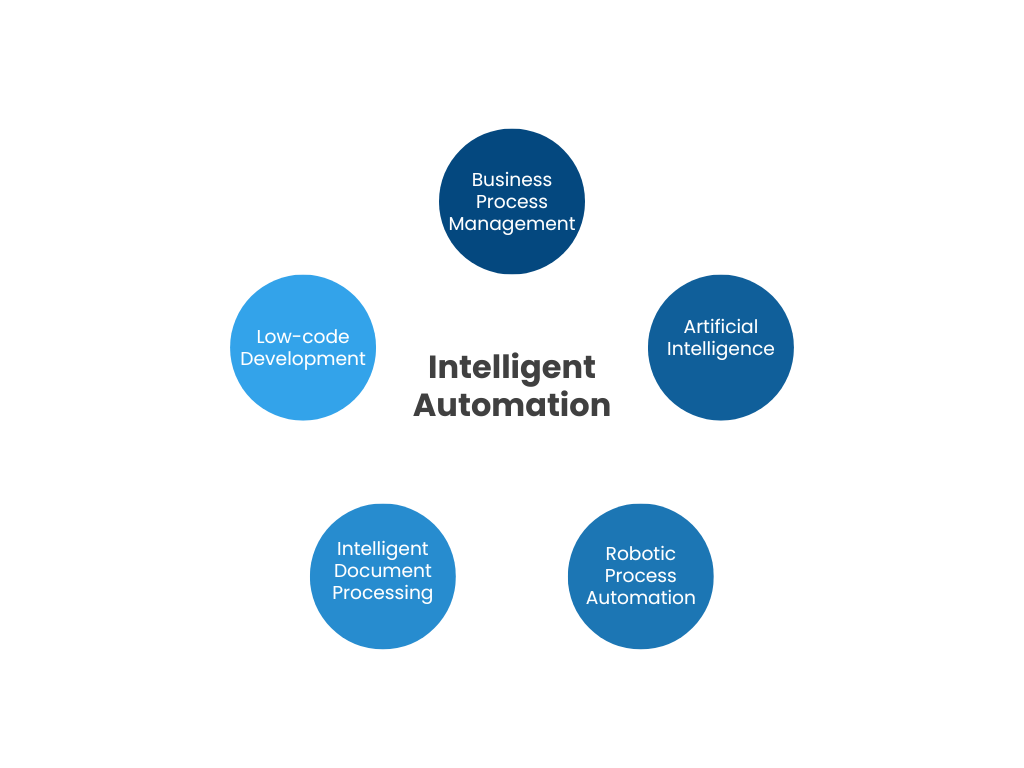What technology do 6 in 10 organizations thank for recent revenue increases? Intelligent automation. Intelligent automation, also known as intelligent process automation (IPA), adds a new layer of smarts to your processes.
New technologies bring their fair share of skeptics, but intelligent automation sidesteps doubt. Here’s a beginner’s guide to kick-starting a winning automation strategy for 2024.
How does intelligent automation work?
Intelligent automation combines different technologies to create the perfect solution for repetitive and manual tasks. You can join companies reveling in IA success by renovating workflows with cognitive computing like artificial intelligence, robotic process automation, and intelligent document processing.
There are dozens of technologies used for enterprise automation. After all, there’s no one way to automate. But at the core of intelligent automation, you’ll find five technologies helping organizations drive $6.6 trillion in productivity growth by 2030.

Business process management (BPM)
A business process management (BPM) platform can turn work into automated, self-driving processes. Workflows include tasks conducted by employees, software, robots, AI tools, point solutions, and legacy systems. A process can be as simple as emailing an approving manager a time-off request. It can be as sophisticated as managing a 100,000-strong fleet of delivery vehicles or healthcare records.
Artificial intelligence
Artificial intelligence harnesses complex algorithms to comb through the two types of data plaguing organizations: structured and unstructured. Before AI, organizations leaned on complex, time-consuming methods of sifting through large volumes of data. Meta-tagging, rigid file structures, and weeks’ worth of swivel-chair tasks. Now, AI crunches through data at warp speeds to:
- Identify new business opportunities
- Find redundant workflow tasks
- Mine customer conversations for business insights
- Pinpoint personalized customer habits
- Predict future cash flow or issues in the supply chain
Robotic process automation (RPA)
Robotic process automation (RPA) technology performs admin tasks autonomously. Define a recipe of keystrokes and clicks, and RPA will handle it swiftly. RPA bots are the go-to tech to automate routine back-office tasks like filing, extracting data, and transferring files. While traditional RPA sticks to preset commands, AI is now upskilling traditional bots with more cognitive abilities.
Intelligent document processing (IDP)
Intelligent Document Processing (IDP) assists with the document haul. This technology helps you rapidly manage and organize a high volume of documents.
IDP opens up the information contained in your documents—whether they’re PDFs of digital forms, scans of handwritten applications, or a bounty of emails—and readies it for use. Extract key details, like taxpayer ID, from thousands of forms instantly. Paired with a BPM platform, information becomes a live part of your processes. Create workflows that grab data from a set of documents or pass the details between systems.
Low-code development
Employees can build apps, dashboards, and processes as effortlessly as PowerPoint presentations or Canva projects. Low-code interfaces invite everyone in your organization to participate in development projects without coding experience.
Getting started with intelligent automation
Forrester warns companies against “random acts of automation.” Hopping in without a strategy won’t rack up the advantages enjoyed by companies with a plan. Here’s how to prepare a winning automation initiative.
Awash in automation excitement, it might feel like it’s pedal to the metal to turn every task over to machines. But not so fast; not all processes are suitable for automation. Look for processes that happen frequently, rarely require human scrutiny, or devour labor hours you’d prefer to divert elsewhere.
Interview and observe stakeholders: Watch key players in action. Perhaps you’d like to automate many under-the-hood manual tasks in onboarding new customers. Sit in with sales, accounting, and marketing team members to see what the process truly entails. List each detailed step that happens along the way.
Don’t forget to explore dependent tasks. Processes are interconnected. They can involve different departments, software types, or people who work halfway around the world. Follow the breadcrumbs to find tasks part of the larger workflow—automating one may require automating others, too.
Pick processes that hit your targets. Goals to shift resources, reduce costs, or save time require different attack strategies. Make sure your chosen process aligns with your overall objectives.

Prioritize based on potential impact: For proof of concept, start with more minor or majorly inefficient processes that will win quick results.
Prepare a process map: Here’s where you funnel your research into a draft process. You can use a whiteboard, sketch BPMN symbols on paper, or use the process mapping feature in your favorite BPM. Begin by naming the start and end points of the process. Fill out the in-between with key players and decision points. Present your flowchart to the people you interviewed to ensure no step goes unnoticed.
By carefully attending to these elements, your automation strategy will become the blueprint for future scaling.
Key elements of a winning intelligent automation strategy
You’ve selected the ideal process for your intelligent automation pilot project. Now, it’s time to rally the team around your plan.
Embarking on an automation project without a well-defined strategy is like sailing without a compass. You need a strategic framework to reach organizational objectives and enjoy measurable results.
Define clear objectives
Before any automation takes place, you must define the objectives and goals your project aims to achieve. These could range from improving operational efficiency and reducing error rates to enhancing compliance or the customer experience. Specific, measurable, achievable, relevant, and time-bound (SMART) goals provide a benchmark for project success and offer a reference point for stakeholders at various project stages.
Build out cross-functional fusion teams
Automation rarely exists in a silo. It usually touches on multiple departments—IT, marketing, HR, and finance—and can extend to teams around the globe.
Bring together a panel of rockstar talent known as fusion teams. This can consist of decision-makers, IT pros, subject matter experts, and enthusiastic individuals with a tech-savvy flair. The more points of view you can welcome, the greater the likelihood that your intelligent automation pursuits will scale throughout your organization.
Communication is key
Mention “automation” in the break room, and you’ll ruffle a few feathers. After all, we’re bombarded by daily headlines about AI displacing jobs, so you may experience some pushback.
But newsflash: smart organizations aren’t using automation as a job grim reaper. They’re using it to speed up mundane computer work so people’s top talents can shine brighter: creativity, critical thinking, intuition, and TLC-laden customer relations. Automation is meant to clear the way—not clear people out. Humans-in-the-loop automation (HITL) combines machine speed with inimitable human consciousness.
Define clear objectives, carve out new roles and expectations for your top talent, and invite team members around your automation roundtable. Most importantly, don’t keep automation plans in the dark. By sinking these three principles into your plan, you’ll reap the benefits of automation and achieve what 31% of companies using AI are striving for: to free up workers to be more creative.
Choosing the right automation tools
The final step involves selecting your automation partner. There are more vendors than types of automation, making this a head-scratching phase for automation greenhorns. Follow these considerations to make sure you have the right intelligent automation vendor at your side.

A focus on the future of artificial intelligence
From chatbots to process mining, artificial intelligence ushers in a new era of cognitive computing. According to one Forbes Advisor survey, 64% of businesses believe AI will increase productivity. But, not every business process automation partner is focusing on it. From AI-enabled IDP to ultra-low-code process model generation, select an intelligent automation vendor that puts AI first.
A process orchestration mindset
You might start with a small process, like extracting the information in a sales contract into your CRM. But as you scale an intelligent automation initiative, process orchestration reigns as your most important decision factor.
Gartner ranks the technology as one of its top-most innovation drivers. It’s expected to rake in $22.9 billion by 2030. What makes process orchestration so meaningful?
It combines all your processes in one place, giving you end-to-end command over your entire automation journey. Instead of running marketing automations in app A and invoicing in app B, all your automations filter through one platform. This gives you unparalleled insight into the greater automation picture. Make adjustments, identify redundant tasks, and find ways to streamline dozens (if not hundreds!) of parallel processes.
More questions to think about…
Do you need to perform a data cleanse? Artificial intelligence and machine learning only produce results as strong as the data you feed them. You might need to clean up your data before it’s ready for next-gen tools.
What works best with your existing infrastructure? Are you running a collection of point solutions? Do you rely extensively on legacy software? Taking the automation plunge doesn’t mean you need to reinvent the wheel. But, you will need to pair with a vendor able to connect with the systems most valuable to your operations.
Are all stakeholders on the same page strategy-wise? One Big Pharma exec laments the years he’s been involved with digital initiatives: very few made it to the finish line. Project leaders and managers differ on the budget or deliverables. The timeline isn’t flexible enough to prepare for unanticipated delays. Ensure everyone on your team agrees on all plan points before diving in feet first.
Picking the right vendor doesn’t need to be a challenge. Explore the pros and cons of ten of the most prominent intelligent automation vendors so you can select the best one for you.
Intelligent automation is on a fast track to become smarter than ever. It’s not science fiction; it’s your new competitive edge. That’s why over 40% of organizations use intelligent automation to optimize internal operations. Organizations readying their processes with AI, RPA, IDP, and other intelligent technology are establishing themselves as major industry players.
How does IPA boost Hyper-Productivity?
Intelligent process automation (IPA) can be a game-changer for your organization in more ways than one. One of the most significant ways you can transform your workflow is by boosting Hyper-Productivity. Instead of simply being productive, your team can become Hyper-Productive, completing work faster and more efficiently than ever.
It’s the next leap in digital transformation—and we’re here to guide you through it all. Chat with us to learn how intelligent automation can benefit your organization.





